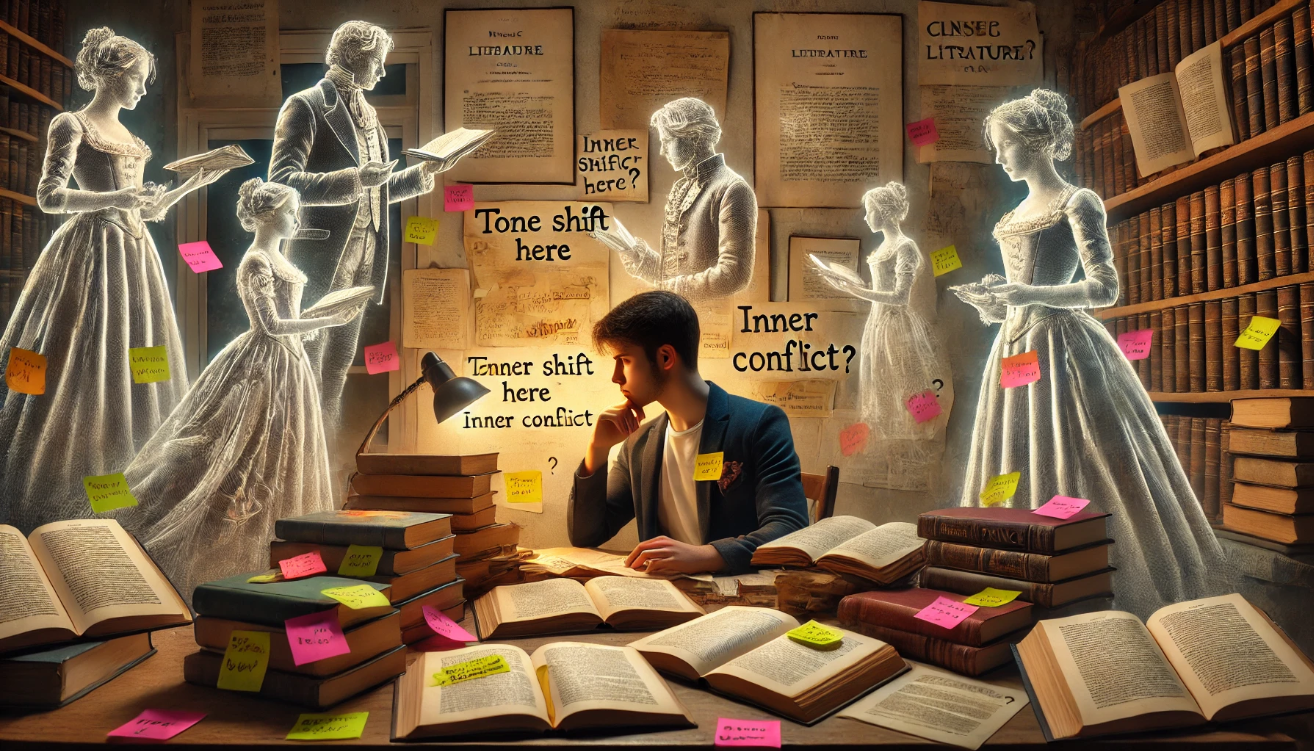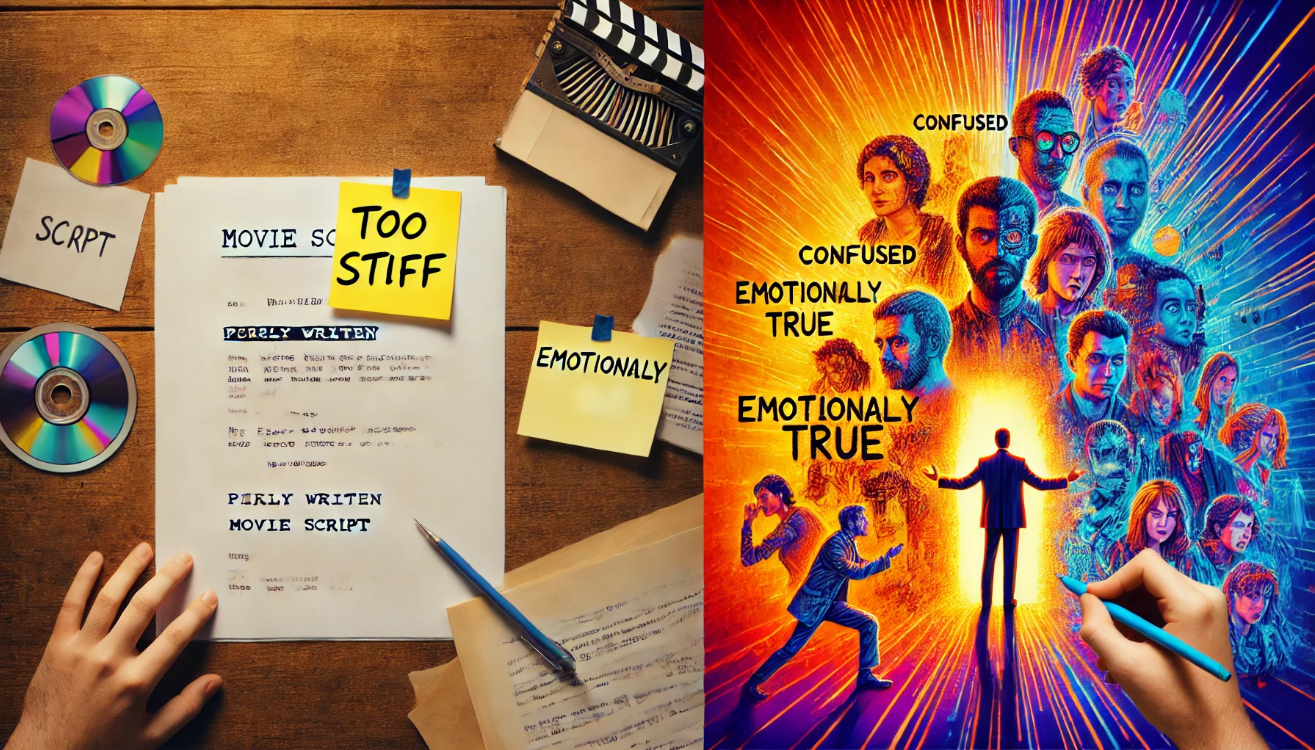
How Soliloquies Enhance Character Development: A Practical Guide for Writers and Literature Students
Ever wondered how some characters feel so real—as if you’ve stepped inside their minds? 🎭 That’s the power of soliloquies and character development working together. Whether you’re a writer struggling to reveal a character’s true motives or a student trying to decode Shakespeare, the challenge is the same: understanding what makes characters tick. Soliloquies offer a rare window into a character’s inner world—but most people miss how to use or analyze them effectively. In this practical guide, you’ll discover how soliloquies can unlock deeper storytelling, richer essays, and unforgettable characters. Ready to level up your insight? Let’s dive in.
Table of Contents
Toggle1. What Is a Soliloquy? 🎭

A soliloquy is a powerful literary device where a character speaks their thoughts out loud—usually while alone—so the audience can hear what’s really going on inside their mind. It’s like reading someone’s inner diary, live on stage or on the page. 😊
Unlike a monologue, which is often spoken to other characters, a soliloquy is directed to no one. It’s a private moment made public for the sake of storytelling.
Why Does It Matter?
Soliloquies reveal a character’s deepest fears, dreams, doubts, and decisions. They’re a direct line to the character’s soul, allowing writers to show emotional depth and students to analyze hidden layers.
For example, when Hamlet says, “To be or not to be…”, he isn’t just talking—he’s wrestling with life, death, and meaning. That single soliloquy tells us more about his internal struggle than pages of dialogue ever could.
Quick Breakdown:
- 👤 Who speaks? A character alone or believing they’re alone
- 🧠 What’s shared? Honest, raw inner thoughts
- 🎬 Where it appears? Plays, novels, film, and even modern TV (think Fleabag or House of Cards)
Soliloquies aren’t just for Shakespeare. Writers use them to reveal motivation, and students analyze them to unlock character arcs. Once you understand how they work, you’ll never look at a story the same way again.
2. Why Soliloquies Matter in Character Development 🧠✨

Soliloquies do more than fill a page or stage—they unlock the emotional and psychological layers of a character that the audience would never see otherwise. Whether you’re writing fiction or analyzing literature, understanding how soliloquies work can help you uncover or create truly memorable characters.
🎯 They Reveal the Inner Conflict
Characters often say one thing in dialogue and feel another inside. A soliloquy strips away the mask. It shows the audience what the character is really thinking—even when they’re unsure themselves.
Example: In Macbeth, when Macbeth says, “Is this a dagger which I see before me?”, we’re not just watching a man see visions—we’re witnessing guilt, fear, and ambition collide in real time.
🔍 They Deepen Emotional Connection

By hearing a character’s raw, unfiltered thoughts, the audience forms a personal bond. It’s intimate—almost like being let in on a secret. This makes the character more relatable, complex, and human.
🔄 They Show Change Over Time
Soliloquies often mark key turning points in a story. As characters face internal struggles, their soliloquies help track how their thoughts evolve. That internal shift is the heart of great character development.
Writers: Use soliloquies to spotlight emotional or moral crossroads.
Students: Pay attention to how the character’s tone or beliefs shift—those changes reveal key themes and arcs.
🧰 Practical Takeaway:
Benefit of Soliloquy 💬 | Impact on Character Development 📈 |
Reveals true motives | Adds psychological depth |
Highlights conflict | Builds emotional complexity |
Marks transformation | Tracks growth or downfall |
Soliloquies aren’t just a storytelling technique—they’re a bridge between character and audience. Whether you’re writing your own story or analyzing someone else’s, recognizing this can take your work from surface-level to unforgettable.
3. Practical Tips for Writers – How to Write Effective Soliloquies ✍️🧠

Writing a soliloquy might seem intimidating, but it’s actually one of the most powerful tools in your storytelling toolbox. A well-written soliloquy can reveal your character’s deepest fears, dreams, and decisions—turning them from flat to unforgettable.
Here’s how to craft soliloquies that feel authentic, emotional, and essential to your character’s journey:
🎯 1. Know Your Character Inside and Out
Before your character speaks, you need to understand what they want, fear, and regret.
Ask yourself:
- What is my character struggling with?
- What are they hiding from others—but not from themselves?
Pro Tip: Pretend you’re interviewing your character. Their soliloquy is their answer.
🕰 2. Choose the Right Moment
The most powerful soliloquies happen when something shifts—a decision is looming, a secret is weighing them down, or they’ve reached a breaking point.
Pick moments of emotional tension, where silence would be too empty, but action is still undecided.
Think: crossroads, crises, or quiet moments just before major change.
🗣 3. Use Their Voice, Not Yours
Write the soliloquy in your character’s own unique voice. Are they poetic, sarcastic, blunt, anxious, dreamy? Their word choices should reflect that.
A teen character won’t speak like a 17th-century philosopher—and that’s okay!
💬 4. Show Emotion, Not Just Information
Soliloquies aren’t meant to dump backstory. They should reveal emotion, inner conflict, and personal truth.
Instead of:
🛑 “I was born in the village and now I must leave.”
Try:
✅ “Why does home suddenly feel so small? Like I can’t breathe unless I leave it behind…”
🔁 5. Read It Aloud and Revise
Good soliloquies have rhythm and honesty. They sound natural when spoken—even if they’re full of emotion or confusion.
Read yours out loud. If it feels forced or stiff, simplify the language or break it into shorter thoughts.
🧪 Bonus Exercise: Try These Soliloquy Starters
Need a jumpstart? Have your character finish one of these lines:
- “If they knew what I was really thinking…”
- “No one sees the truth, not even me…”
- “What if I choose wrong—again?”
Soliloquies aren’t just dramatic moments—they’re emotional truth-telling. Use them wisely, and your characters will not only speak more clearly, they’ll connect more deeply with your readers. 😊
4. Literary Analysis – How to Analyze Soliloquies for Character Insight 🔍📚
Whether you’re writing an essay, prepping for an exam, or simply trying to understand a character better, analyzing soliloquies is a smart and effective way to dig beneath the surface. Soliloquies aren’t just dramatic speeches—they’re windows into a character’s mind and heart. 😊
Here’s a beginner-friendly guide to help you analyze soliloquies like a pro 👇
1: Identify the Context

Start by asking:
- When does the soliloquy happen?
- What just happened before this moment?
- Why is the character alone or speaking to themselves?
Understanding the setup helps you see why the soliloquy matters in the story.
2: Look for Emotional Clues
Soliloquies often reflect raw, unfiltered emotion. Look closely at:
- Tone (angry, sad, confused, hopeful?)
- Repetition (is something weighing heavily on their mind?)
- Imagery or metaphors (what symbols reflect their inner state?)
These clues show what the character is really feeling—even if they don’t say it directly.
3: Track Character Growth or Conflict
Ask yourself:
- Does the character change during the soliloquy?
- Are they torn between two choices or ideas?
- What new realization do they have?
A great soliloquy often captures a turning point in the character’s journey.
4: Highlight Key Lines
Pick out 1–2 powerful lines and explain:
- What do they reveal about the character’s mindset?
- How do these lines connect to the larger theme or plot?
Example: In Hamlet’s “To be or not to be,” the phrase reveals not just fear of death, but fear of the unknown. That’s a huge part of his internal struggle.
5: Connect to Bigger Ideas
Finally, link the soliloquy to:
- The theme of the work (e.g., power, guilt, identity)
- The character arc (how they’ve changed or where they’re headed)
- The author’s intent (what message or feeling is being conveyed?)
✅ Quick Checklist for Soliloquy Analysis:
- When and why does it happen?
- What emotions are expressed?
- Is there inner conflict or change?
- What lines stand out and why?
- How does it relate to the bigger story?
Soliloquies aren’t just about what’s said—they’re about what’s revealed. Mastering this kind of analysis will help you write stronger essays, participate in class with confidence, and understand stories on a much deeper level. 💡📖
5. Case Studies of Soliloquies That Drive Character Development 🎭📚
To truly understand the power of soliloquies and character development, it helps to see them in action. Below are famous case studies—from classic plays to modern storytelling—that show how soliloquies reveal inner conflict, transformation, and emotional depth.
Each example gives you practical insight into how soliloquies work—and how you can use or analyze them effectively. 😊
🧩 Hamlet – “To be or not to be” (Shakespeare)

This is the most iconic soliloquy in literature. Hamlet contemplates life, death, and the fear of the unknown.
What it reveals:
- His internal battle with depression and indecision
- His fear of action and its consequences
- His philosophical depth and emotional vulnerability
📌 Takeaway: This soliloquy doesn’t move the plot—it deepens our emotional understanding of Hamlet, which makes his later actions more meaningful.
⚔️ Macbeth – “Is this a dagger which I see before me” (Shakespeare)
Spoken just before Macbeth murders King Duncan, this soliloquy captures the moment ambition collides with guilt.
What it reveals:
- Macbeth’s fear and psychological unraveling
- His awareness of right vs. wrong
- The beginning of his descent into madness
📌 Takeaway: The soliloquy lets us feel Macbeth’s inner chaos, showing how his character begins to transform from hesitant to ruthless.
💔 Fleabag – Breaking the Fourth Wall (TV)
In Fleabag (Phoebe Waller-Bridge), the main character regularly speaks directly to the camera—modern soliloquy style.
What it reveals:
- Her loneliness, trauma, and emotional self-protection
- Her desire for connection beneath her humor
- A slow-burning transformation from avoidance to vulnerability
📌 Takeaway: These moments act as soliloquies that build a raw, honest relationship between the character and the viewer.
🌊 Mrs. Dalloway – Internal Monologue (Virginia Woolf)
In this modernist novel, Woolf uses stream-of-consciousness to show Clarissa Dalloway’s unspoken thoughts.
What it reveals:
- Her reflections on aging, time, and missed opportunities
- Her complex feelings about marriage, love, and identity
- A layered character whose emotional landscape is rich and real
📌 Takeaway: Soliloquy-style narration deepens character development without traditional “speeches.”
🧠 Key Lessons for Writers and Students:
- Soliloquies don’t just tell—they reveal what’s hidden.
- They’re most powerful at emotional turning points.
- Whether in classic plays or modern shows, soliloquies offer a direct path into a character’s truth.
Studying these examples helps you write stronger internal moments or analyze literary characters with clarity and confidence. Try looking for soliloquies in your favorite stories—you’ll be amazed at what you uncover.
6. Common Mistakes to Avoid (For Writers and Students)

Soliloquies are a powerful tool—but only when used effectively. Whether you’re writing them or analyzing them, a few common mistakes can weaken the impact and clarity of your work. Here’s how to avoid them and get the most out of every soliloquy. 😊
1: Using Soliloquies as Info Dumps
Don’t use soliloquies to explain backstory or plot details the audience already knows.
🛠 Fix: Focus on emotion and internal conflict. A soliloquy should reveal what the character can’t say out loud—not just fill in gaps.
2: Breaking Character Voice
If your character suddenly sounds like a philosopher or narrator instead of themselves, the soliloquy feels forced.
🛠 Fix: Stay true to your character’s tone, background, and personality. Their internal voice should match how they speak and think.
3: Ignoring Timing and Relevance
Dropping a soliloquy in the wrong moment can break tension or feel out of place.
🛠 Fix: Use soliloquies at emotional turning points—when a decision, realization, or breakdown is building.
4: Over-Analyzing Without Interpretation (Students)
Listing what’s said in a soliloquy without explaining why it matters leads to surface-level analysis.
🛠 Fix: Always ask:
- What does this reveal about the character’s mindset?
- How does this soliloquy affect their choices or growth?
5: Forgetting Structure and Flow (Writers)
A rambling soliloquy with no direction loses emotional impact.
🛠 Fix: Give the soliloquy a clear arc:
- Start with a thought or problem
- Explore the emotion or conflict
- End with a decision, question, or shift in tone
7. How to Use Soliloquies to Improve Your Own Writing or Analysis

Soliloquies aren’t just for Shakespeare—they’re powerful tools you can use to enrich your storytelling or literary analysis. Here’s how:
🖋️ For Writers: Deepen Character Voice and Motivation
Want your characters to feel real and complex? Try writing a soliloquy from their point of view. Let them speak directly to the audience—or even just to themselves.
Ask:
- What are they afraid to admit out loud?
- What do they really want?
Writing internal monologues helps reveal hidden layers of motivation and can spark key plot developments.
📚 For Literature Students: Unlock Deeper Meaning
When analyzing a soliloquy, go beyond surface meaning. Focus on:
- Tone shifts (anger, doubt, guilt)
- Repetition or contradictions
- Metaphors and imagery
These clues reveal what the character struggles with—and how that reflects the play’s larger themes.
🛠️ Bonus Tip: Try It Yourself!
Pick a well-known character (from Shakespeare or modern fiction) and write a short soliloquy for them. It’s a fun, creative way to improve both critical thinking and writing skills 😊
Let Characters Speak from the Soul
Soliloquies are more than dramatic flourishes—they are storytelling gold. Whether you’re a writer developing multidimensional characters or a student analyzing literary texts, soliloquies offer unmatched insight into the human psyche. By stepping inside a character’s thoughts, you uncover their fears, hopes, and moral dilemmas—those deeply personal moments that drive meaningful change.
Mastering the use or analysis of soliloquies can elevate your writing ✍️ and sharpen your interpretive skills 📚. So next time you encounter a soliloquy, don’t skim—listen closely. It might just teach you more about character development than a dozen plot twists ever could.
Frequently Asked Questions (FAQs)
1. What is a soliloquy in literature?
A soliloquy is a speech where a character speaks their thoughts out loud, usually while alone, revealing their inner emotions, conflicts, or decisions. It’s a tool used by writers to show what a character truly feels without outside influence.
2. How does a soliloquy help in character development?
Soliloquies reveal a character’s inner world—fears, desires, doubts—that they may hide from others. This deepens emotional connection with the audience and shows personal growth, internal conflict, or moral dilemmas.
3. What’s the difference between a soliloquy and a monologue?
A soliloquy is spoken to oneself (or directly to the audience) and reveals private thoughts, while a monologue is typically spoken to other characters. Soliloquies are more introspective and used to explore character psychology.
4. How can writers use soliloquies effectively in their stories?
Writers should use soliloquies at key emotional moments—when a character is making a tough decision or facing internal conflict. Keep the language true to the character’s voice and focus on emotion, not just information.
5. Why are soliloquies important in plays like Shakespeare’s?
In Shakespeare’s plays, soliloquies give the audience insight into a character’s motivations and moral struggles. Famous examples like “To be or not to be” allow us to understand characters on a much deeper level than action or dialogue alone.
6. Can soliloquies be used in modern writing or TV shows?
Yes, modern shows like Fleabag and House of Cards use soliloquy-like moments where characters break the fourth wall and reveal their inner thoughts. In fiction, internal monologue serves a similar purpose.
7. How do students analyze soliloquies in literature?
Start by identifying when and why the soliloquy occurs, then examine the emotions, tone, and imagery. Focus on what it reveals about the character’s mindset, choices, and how it connects to the story’s larger themes.
8. What are common mistakes to avoid when writing soliloquies?
Avoid info-dumping or making the character sound unnatural. Instead, stay in the character’s voice, focus on emotional honesty, and use soliloquies during turning points where the audience needs to see what the character is truly thinking.
